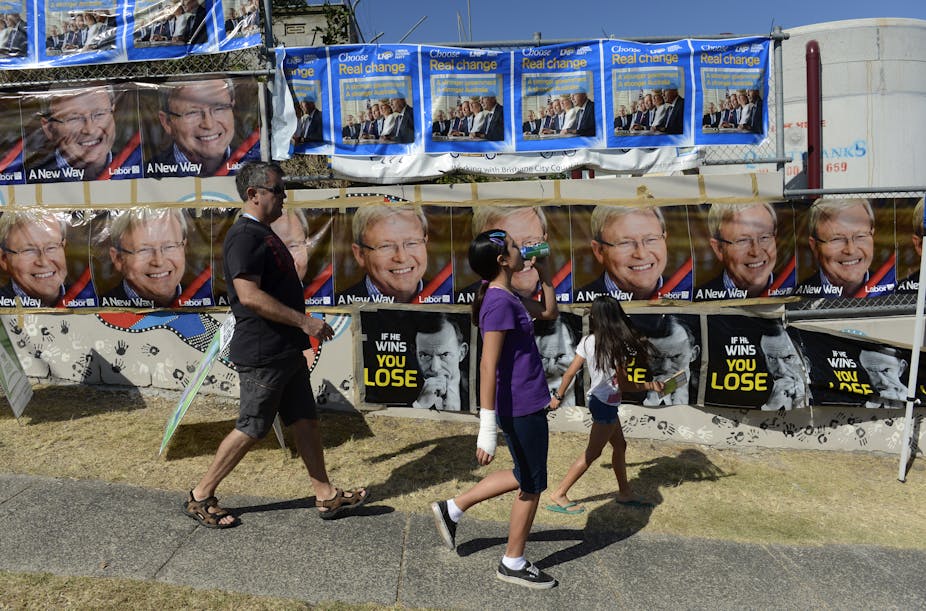The election is over, and the result was pretty much as expected, according to the commentators, polls, and the betting companies. Yet, despite the predicted outcome, Australians were bombarded with ad after ad throughout the five-week campaign.
Political advertising is just one of many factors that influences voter behaviour, yet the parties still spend big. Major and minor parties strategically used advertising to promote candidates, raise issues, explain policies, present their points of view, counter opposition claims, express doubts, mistrust and faults about the opposition, and, of course, win votes.
So how did the election advertising war between the various parties play out?
The 2013 campaign
When prime minister Kevin Rudd announced the election date he also put political advertising squarely on the table to the electorate, indicating what sort of campaign he would run:
I believe all Australians are sick and tired of negative politics.
He also noted the wave of negative advertising the Liberals would run:
Our opponents are outspending us in this campaign 10 to one on negative ads.
The ALP campaign started with the slogan “A New Way”, and then announced that former Queensland premier Peter Beattie would be a candidate standing for the seat of Forde. The Liberal Party launched its campaign “New Hope”, possibly to prove that it wasn’t a party of three-word slogans.
Ignoring Kevin Rudd’s plea to “raise the standards” of electioneering, the ALP then ran a series of ads directly attacking Tony Abbott, including the 2013 version of Whinging Wendy – Sour Susie – asking: “what are you hiding Mr Abbott?” regarding the Liberal Party’s costings and cuts. This was followed by “if he wins, you lose”.
Union-sponsored negative ads from the ACTU, and the nurses and teachers unions were also broadcast.
The Liberal Party ran a positive ad “Our Plan”, which summarised the “Our Plan – Real Solutions for all Australians” booklet that the candidates carried around at chest height in as many TV interviews as possible.
It also released its negative “Captain Chaos” ad which stated “It’s a Ruddy Mess… Imagine three more years of Labor Failure”, and at the end of the campaign the “Labor Greens Spring Clean” ads.
According to advertising monitoring company ebiquity, the Liberal Party spent more on TV, radio and press advertising during the campaign than the Labor Party. The figures indicate the Liberals’ spending was A$6.75 million, compared with the ALP’s A$4.04 million.
After the Liberals and ALP, the next big spenders were the Palmer United Party (A$3.02 million) and the Australian Salary Packaging Industry Association (A$1.48 million).
The debut of the Palmer United Party made a big impact in the campaign. The biggest media spend for an individual ad was “Revolution” by the Palmer United Party (A$1.78 million) which was followed by the Liberals’ “Captain Chaos” (A$1.27 million), and the ALP’s “You Lose” came fifth.
So was there an avalanche of negative ads from the Liberal Party? Of 26 advertisements run by the Libs only 10 (or 38%) were negative, while the ALP ran 28 advertisements with 21 (or 75%) being negative. Although looking at the number of ads, the Liberals actually ran their negative ads more times than Labor.
Advertising as a political tool
Studies have shown that there is a positive relationship between political advertising and voters’ knowledge of and interest in a campaign. But if there are problems with the candidate or party, no amount of advertising can change people’s minds.
From a marketing sense, it is very difficult to successfully promote a bad product. Besides, many people decided who they would vote for well before the campaign was announced and a simplistic 30-second ad will not change their mind.
In some ways, political advertising is a much weaker form of communication than factual stories. Political gaffes, a candidate not knowing policies, and even comments from make-up artists can have more power in a campaign.
Generally, advertising does not appear to play a significant role in the final result of the election; rather the leaders, events, and the nature of the election are more important. If the mood is for change, then no amount of advertising can stop it.
The value of election advertising
Yet, political advertising can be an important tool for political parties. Not only can the advertising encourage awareness of candidates (such as Clive Palmer) and the leaders, it can also raise, summarise, emphasise and reinforce an issue – questioning of the Liberal’s education and hospital funding cuts by the teachers’ and nurses’ unions, is just one example.
Setting the agenda on big issues can be a major advantage for a political party or a group, and an advertisement can be vital to point to an issue when the party wants, and possibly encourage news, online, talkback, and word-of-mouth discussion.
While it might not change a voter’s vote, it can strengthen the reason for their voting decision. Advertising can help polarise voters’ assessments, either reinforcing positive views of the candidate or negative views of the opposing party; which can be important in swinging seats.
It was estimated that during this election the Coalition and the ALP would each spend up to A$25 million over the campaign. Although political advertising is a major form of political communication, there is a feeling that its overall effect is over-emphasised, as those who were expected to win still won.
However, some in Labor would feel that their negative advertising would place enough fear and doubt that the landslide some predicted did not occur, and so the advertising was justified. Also, for Clive Palmer to come from obscurity to having a few positions in parliament, the advertising would also take some credit.
And the overall winner? The advertising agencies and media.

